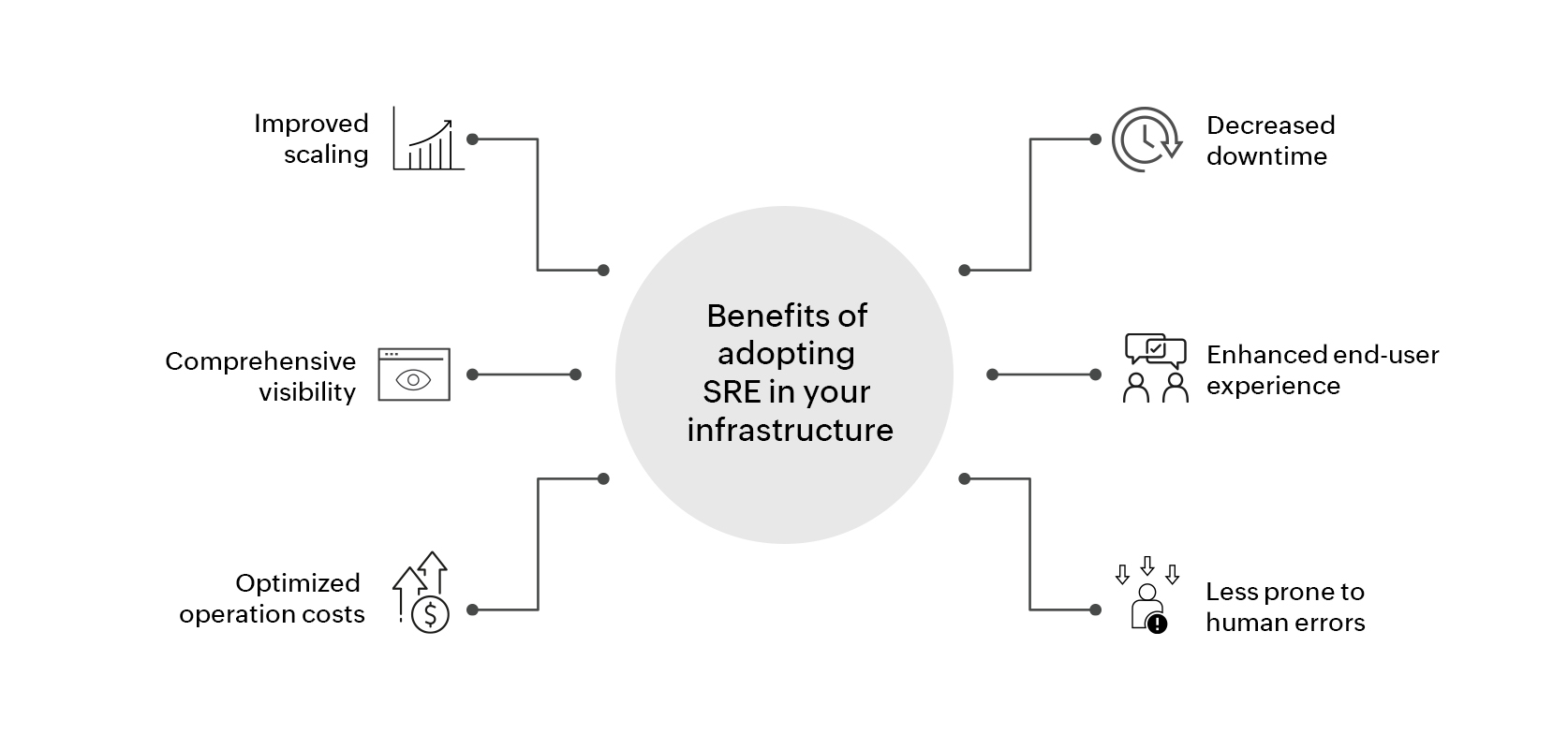As organizations around the world strive to develop a secure, reliable, scalable, and sustainable IT infrastructure, there's a growing need for efficient infrastructure monitoring and management. Businesses are trading non-scalable legacy architecture for modern solutions. Fueled by cutting-edge technologies, these make the infrastructure management process smoother and easier. One such technology is site reliability engineering (SRE), which helps scale your infrastructure management process.
SRE is the process of implementing software engineering techniques that automate the infrastructure management process by bringing the development and operations team together. The concept was introduced by Ben Treynor Sloss, vice president of engineering at Google, who famously said, "SRE is what happens when you ask a software engineer to design an operations team."
The goal of a development team is to create and release frequent updates to ensure a seamless end-user experience. On the other hand, the operations team will not want to release any updates without first ensuring the network will stay reliable post update. More often than not, the development and operations teams find themselves at odds with each other.
SRE focuses on developing and managing a sustainable and reliable network that delivers a seamless end-user experience, while also making sure that the infrastructure is functioning properly.
In a fast-paced environment such as an enterprise IT infrastructure, where there can be an enormous number of incidents and events, there is only so much a network admin can do to manage everything. With more businesses transitioning towards a cloud-oriented approach, or even a cloud-native approach, the need for SRE is imminent. By implementing SRE and automating the monotonous tasks associated with network management, IT admins can optimize their infrastructure for better performance.
The following are some of the key benefits of adopting SRE in your environment.

SLAs are a set of conditions (usually a quality of service over a particular period of time) that must be met by a service provider. Failing to meet the set demands can result in penalties and a negative brand reputation. This can prove to be a major hurdle when trying to reach business goals. By deploying SRE to your infrastructure, you can have holistic visibility into your network, track critical metrics, and make sure that your infrastructure stays compliant with SLAs.
The following are some of the key metrics associated with SLAs.
1. Service-level objective (SLO): An SLO is the quality of service that a service provider promises to provide their client under the SLA. By defining SLOs, service providers can quantify the quality of service they are obligated to make. This helps them decide whether to make the infrastructure more reliable and keep the updates to a minimum or have a fast-paced infrastructure by deploying frequent updates to stay on par with the demand. Using SRE, organizations can optimize their infrastructure according to the SLO set in their SLA.
2. Service-level indicator (SLI): An SLI is the availability metric of your infrastructure. SLIs are always optimized to meet the contractual SLOs. If the SLI falls below the SLO, that might result in the breach of the SLA. By deploying SRE, organizations can have increased control over their infrastructure to help them with high uptime, which ultimately helps the SLI meet the set SLO.
3. Error budget: Error budget is the maximum amount of downtime a client can endure before the service is restored. By specifying the quality of service in SLAs, organizations can better assess their infrastructure's future goals. With SRE, organizations can fully understand their infrastructure, set the appropriate error budget, and decide on the amount of reliability the infrastructure has to offer, while scaling it to the maximum for improved performance.
ManageEngine OpManager Plus is a comprehensive IT operations management toolkit that helps you monitor, observe, and manage your entire infrastructure. With out-of-the-box IT operations management capabilities, OpManager Plus leverages advanced technologies to make the process as smooth as possible. With OpManager Plus, you can:
Monitor your infrastructure efficiently: Monitor the entire infrastructure by constantly tracking your network for specified metrics, thereby ensuring uptime. Also, take advantage of OpManager Plus' AI-enabled features such as adaptive thresholds, forecasting performance trends, and forecast reports. Learn more.
Monitor your network traffic and bandwidth usage: Get increased visibility into your infrastructure's traffic and bandwidth usage patterns and optimize them for better performance. Take a proactive stance towards infrastructure management using network forecasting and network forensics. Learn more.
Get end-to-end infrastructure visibility: Apart from monitoring and managing your infrastructure, it's imperative that you have an in-depth visibility that is not just limited to your devices. Stay ahead of hassles such as rogue device detection and IP conflicts by having a bird's-eye view of your infrastructure. Take into account even the micro-elements such as wires, cables, and interfaces. Learn more.
Manage your firewalls and VPNs to stay security compliant: Automate your compliance audits and enhance your infrastructure security by getting a comprehensive report regarding your infrastructure's potential security breaches. Stay a step ahead of your infrastructure's security vulnerabilities. Learn more.
Manage the configuration changes in your infrastructure: Put standard operating procedures (SOPs) in place, and schedule automatic device configuration backups. Monitor your infrastructure for any configuration violations and immediately rectify them by applying the suitable counter-action. Stay compliant with industry standards and government frameworks. Learn more.
Monitor and enhance your end-user experience: Gain comprehensive visibility into the performance and end-user experience of your business-critical applications. Identify and root out any potential bottlenecks found in the way. Conveniently transition into a more cloud-oriented infrastructure to keep up with your competition and meet your business goals, while not compromising on the quality of the end-user experience offered. Learn More.
Download OpManager Plus for a hands-on experience. Or Learn more about OpManager Plus.